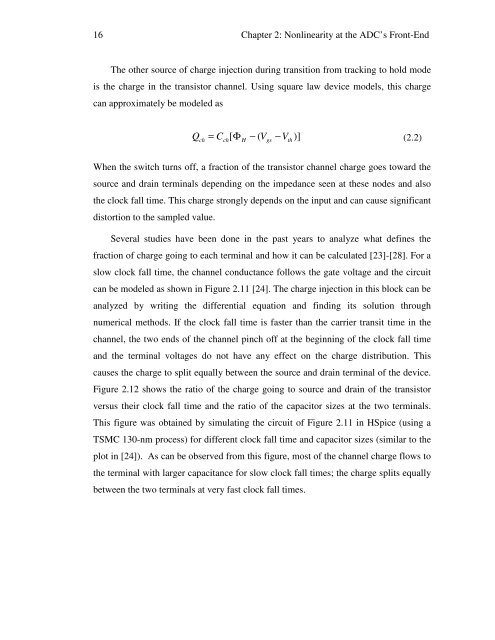digital compensation of dynamic acquisition errors at the front-end of ...
digital compensation of dynamic acquisition errors at the front-end of ...
digital compensation of dynamic acquisition errors at the front-end of ...
You also want an ePaper? Increase the reach of your titles
YUMPU automatically turns print PDFs into web optimized ePapers that Google loves.
16 Chapter 2: Nonlinearity <strong>at</strong> <strong>the</strong> ADC’s Front-End<br />
The o<strong>the</strong>r source <strong>of</strong> charge injection during transition from tracking to hold mode<br />
is <strong>the</strong> charge in <strong>the</strong> transistor channel. Using square law device models, this charge<br />
can approxim<strong>at</strong>ely be modeled as<br />
Q<br />
ch<br />
= C Φ − ( V −V<br />
)]<br />
(2.2)<br />
ch[ H gs th<br />
When <strong>the</strong> switch turns <strong>of</strong>f, a fraction <strong>of</strong> <strong>the</strong> transistor channel charge goes toward <strong>the</strong><br />
source and drain terminals dep<strong>end</strong>ing on <strong>the</strong> impedance seen <strong>at</strong> <strong>the</strong>se nodes and also<br />
<strong>the</strong> clock fall time. This charge strongly dep<strong>end</strong>s on <strong>the</strong> input and can cause significant<br />
distortion to <strong>the</strong> sampled value.<br />
Several studies have been done in <strong>the</strong> past years to analyze wh<strong>at</strong> defines <strong>the</strong><br />
fraction <strong>of</strong> charge going to each terminal and how it can be calcul<strong>at</strong>ed [23]-[28]. For a<br />
slow clock fall time, <strong>the</strong> channel conductance follows <strong>the</strong> g<strong>at</strong>e voltage and <strong>the</strong> circuit<br />
can be modeled as shown in Figure 2.11 [24]. The charge injection in this block can be<br />
analyzed by writing <strong>the</strong> differential equ<strong>at</strong>ion and finding its solution through<br />
numerical methods. If <strong>the</strong> clock fall time is faster than <strong>the</strong> carrier transit time in <strong>the</strong><br />
channel, <strong>the</strong> two <strong>end</strong>s <strong>of</strong> <strong>the</strong> channel pinch <strong>of</strong>f <strong>at</strong> <strong>the</strong> beginning <strong>of</strong> <strong>the</strong> clock fall time<br />
and <strong>the</strong> terminal voltages do not have any effect on <strong>the</strong> charge distribution. This<br />
causes <strong>the</strong> charge to split equally between <strong>the</strong> source and drain terminal <strong>of</strong> <strong>the</strong> device.<br />
Figure 2.12 shows <strong>the</strong> r<strong>at</strong>io <strong>of</strong> <strong>the</strong> charge going to source and drain <strong>of</strong> <strong>the</strong> transistor<br />
versus <strong>the</strong>ir clock fall time and <strong>the</strong> r<strong>at</strong>io <strong>of</strong> <strong>the</strong> capacitor sizes <strong>at</strong> <strong>the</strong> two terminals.<br />
This figure was obtained by simul<strong>at</strong>ing <strong>the</strong> circuit <strong>of</strong> Figure 2.11 in HSpice (using a<br />
TSMC 130-nm process) for different clock fall time and capacitor sizes (similar to <strong>the</strong><br />
plot in [24]). As can be observed from this figure, most <strong>of</strong> <strong>the</strong> channel charge flows to<br />
<strong>the</strong> terminal with larger capacitance for slow clock fall times; <strong>the</strong> charge splits equally<br />
between <strong>the</strong> two terminals <strong>at</strong> very fast clock fall times.
















